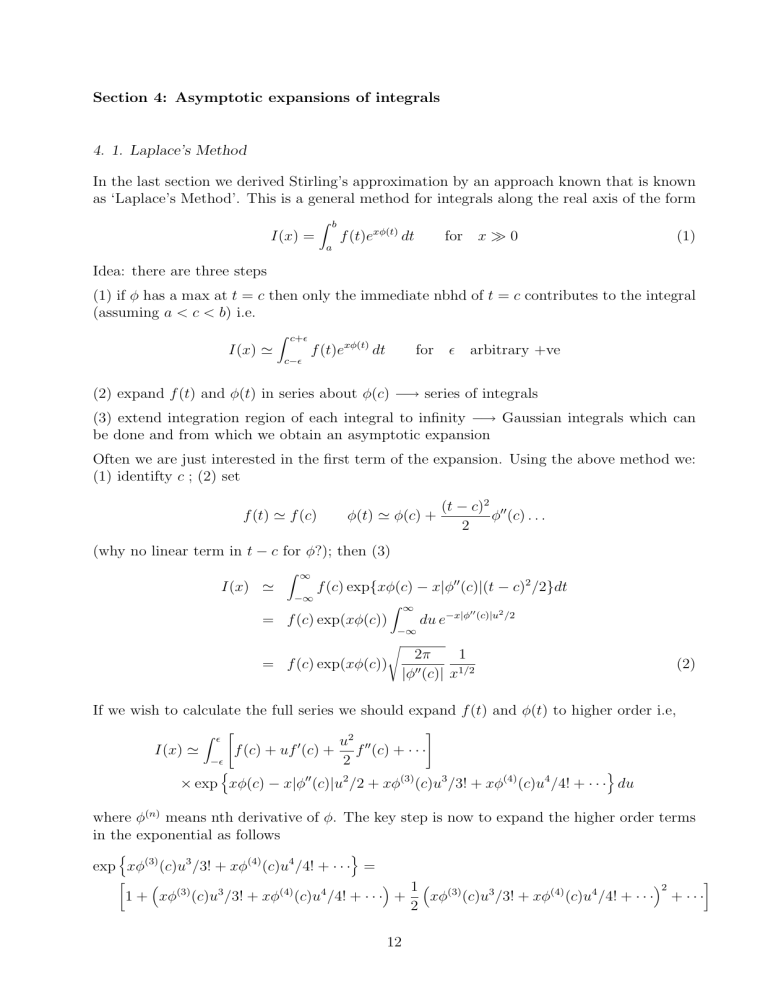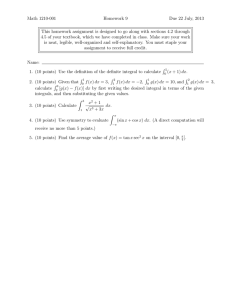Asymptotic Expansions of Integrals: Laplace & Stationary Phase
advertisement

Section 4: Asymptotic expansions of integrals
4. 1. Laplace’s Method
In the last section we derived Stirling’s approximation by an approach known that is known
as ‘Laplace’s Method’. This is a general method for integrals along the real axis of the form
Z b
I(x) =
f (t)exφ(t) dt
for x 0
(1)
a
Idea: there are three steps
(1) if φ has a max at t = c then only the immediate nbhd of t = c contributes to the integral
(assuming a < c < b) i.e.
I(x) ≃
Z c+
f (t)exφ(t) dt
for arbitrary +ve
c−
(2) expand f (t) and φ(t) in series about φ(c) −→ series of integrals
(3) extend integration region of each integral to infinity −→ Gaussian integrals which can
be done and from which we obtain an asymptotic expansion
Often we are just interested in the first term of the expansion. Using the above method we:
(1) identifty c ; (2) set
f (t) ≃ f (c)
φ(t) ≃ φ(c) +
(t − c)2 00
φ (c) . . .
2
(why no linear term in t − c for φ?); then (3)
I(x) ≃
Z ∞
f (c) exp{xφ(c) − x|φ00 (c)|(t − c)2 /2}dt
−∞
= f (c) exp(xφ(c))
Z ∞
00
2
du e−x|φ (c)|u /2
−∞
s
= f (c) exp(xφ(c))
2π
1
00
1/2
|φ (c)| x
(2)
If we wish to calculate the full series we should expand f (t) and φ(t) to higher order i.e,
u2
I(x) ≃
f (c) + uf (c) + f 00 (c) + · · ·
2
−
Z "
#
0
n
o
× exp xφ(c) − x|φ00 (c)|u2 /2 + xφ(3) (c)u3 /3! + xφ(4) (c)u4 /4! + · · · du
where φ(n) means nth derivative of φ. The key step is now to expand the higher order terms
in the exponential as follows
n
o
exp xφ(3) (c)u3 /3! + xφ(4) (c)u4 /4! + · · · =
1 + xφ(3) (c)u3 /3! + xφ(4) (c)u4 /4! + · · · +
12
2
1 (3)
xφ (c)u3 /3! + xφ(4) (c)u4 /4! + · · · + · · ·
2
then we can extend the limit of the integrals to infinity and end up with a plethora of
Gaussian integrals to compute.
The general formula is
Z ∞
n −au2 /2
du u e
−∞
(
=
0√
if n odd
(n − 1)(n − 3)(n − 5)....(3)(1) if n even
a(n+1)/2
2π
(3)
And it remains to collect terms of the same order in x. For example the first correction to
(2) is
s
"
#
2π 1
f (2)
f φ(4)
f (1) φ(3)
5f (φ(3) )2
exp(xφ)
− (2) +
+
−
(4)
|φ00 | x3/2
2φ
8(φ(2) )2 2(φ(2) )2
24(φ(2) )3
where f, φ and derivatives are all evaluated at c. As you can guess this procedure (has)
soon become(s) very tedious! But the important point for us is that it shows we develop an
asymptotic expansion:
s
2π
1
A B
I(x) ∼ exp(xφ(c))
f (c) + + 2 + · · · .
00
1/2
|φ (c)| x
x x
Further Notes
• To bring an integral into the form (1) we sometimes have to knock it into shape by
changing variable etc as we did when we derived Stirling’s approximation
• it may happen that there is no maximum of φ in the interval (a,b) then the integral
will be dominated by one of the endpoints. In this case we have to be more careful
with our expansion about a or b since φ0 generally doesn’t vanish (see tutorial 2.8)
• if there are several maxima in the interval we should consider the highest
4. 2. Method of Stationary Phase
Consider
I(x) =
Z
f (t)eixψ(t) dt
for x 0
(5)
When x is large the integrand will oscillate very rapidly due to the phase factor eixψ(t) . Thus
if f (t) is smooth we expect the contributions to the integral to nearly cancel. But near a
stationary point the oscillation is less rapid since the phase is stationary. Thus we expect
the dominant contribution to the integral to come from near ψ 0 (t) = 0.
Then one proceeds analogously to Laplace’s method and the leading order approximation is
I(x) = f (c) exp(ixψ(c))
Z ∞
−∞
We then use the result (see tutorial)
Z ∞
iαu2
e
r
du =
−∞
13
00
2
du eixψ (c)u /2
π iπ/4
e
α
to obtain
s
ixψ(c)
I(x) ∼ f (c)e
2π
eiπ/4
x ψ 00 (c)
s
ixψ(c)±iπ/4
= f (c)e
2π
1
00
1/2
|ψ (c)| x
where the ± is according to whether c is a min or a max of ψ(t)
Example: Airy integral for large, negative argument
ω3
1Z∞
Ai(−x) =
dω cos
− xω
π 0
3
!
x>0
First note that we may write the integral as
1 Z∞
ω3
Ai(−x) =
dω exp i
− xω
2π −∞
3
"
!#
x1/2 Z ∞
z3
dz exp ix3/2
−z
=
2π −∞
3
"
!#
(ω = x1/2 z)
z3
The stationary points of ψ(z) =
− z are z = ±1 at which f 00 (z) = 2z = ±2. In this
3
case we have two stationary points, the contributions from which we must sum. Expanding
about the stationary points to second order and performing the integral yields
Ai(−x) ≃
x1/2 X Z ∞
dz exp ix3/2 ∓2/3 ± (z ∓ 1)2
2π ± −∞
x1/2 X
π
exp(∓2ix3/2 /3) 3/2
2π ±
x
1
= √ 1/4 cos(2x3/2 /3 − π/4)
πx
=
1/2
e±iπ/4
The method of stationary phase arises in the ‘WKB’ approach to Schrödinger’s equation
(see later) and in path integral formulation of quantum mechanics.
14




